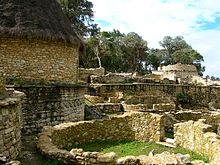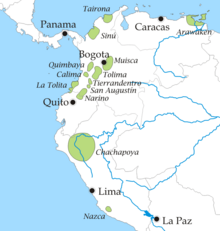Chachapoya
The Chachapoya are a prehistoric Andean people ( indigenous peoples of South America ). The name was given to them by the Inca and means "cloud people" or "fog warriors" in Quechua .
history
When exactly one can speak of a Chachapoya culture is uncertain. It is also controversial when the huge fortress of Kuelap , the most famous testimony of this culture, was built. Earlier estimates were mostly from 800 AD. But the Peruvian archaeologist Alfredo Narváez, who has been responsible for the excavations in Kuelap since 1986, came to a different conclusion based on recent radiocarbon analyzes when asked when Kuelap was built: "The oldest dates we have come from the 6th century, d. H. around the year 500. But we suspect that the work began earlier, perhaps around AD 400 ”.
The German-born Peruvian anthropologist Peter Lerche , who has lived and researched in the Chachapoya area since the early 1980s, concluded from the fact that certain requirements must be met for such a building that the Chachapoya culture began much earlier, possibly 2000 years ago. Lerche made the same statement in March 2013 in a statement for a documentary film production by the TV station Arte about the origins of the Chachapoya culture.
Presumably the Chachapoya were organized in a loose association of states. Only the Inca subjugated the Chachapoya around 1475, shortly before the arrival of the Spaniards. At that time they must have numbered around 500,000 people. A large part of the population was deported, some to Cusco .
Sixty years later, the remnants of the people allied themselves with the Spanish conquistadors against the Inca.
In 1549, 17 years after the arrival of the Spaniards, measles and smallpox had caused the total population to drop to 90,000. Shortly thereafter, they largely died out.
Exploration and discovery

In 1965 the archaeologist Federico Kauffmann-Doig discovered the clay figures called Purunmachus (old men), sarcophagi of the Chachapoya. Up to thirty of them, about 60–110 cm tall, stand in narrow rock niches of the Andes. They represent the connection to the ancestors.
In the 1990s , a larger burial site with mummified bodies was found in northeastern Peru , near Lake Condor . In these and earlier discovered tombs of the Chachapoya, the dead that had previously been buried in the Chachapoya style were dug up and reburied in the Inca style - perhaps to break the Chachapoya resistance against the Inca. The mummies and other finds of the Chachapoya culture have been exhibited in the Centro Mallqui Museum in Leymebamba since 2000 .
In 2004, a research team led by the researcher and journalist Gene Savoy discovered a huge city complex, which extends over at least 65 square kilometers, surrounded by a wall with watchtowers near Ocumal in the province of Luya . Overall, the city on the hills along the Huabayacu River consists of at least six systems that are connected with paved paths. The city was called Gran Saposoa .
The so far biggest fortress of culture is near the city of Chachapoyas lying Kuelap . Not far from here, the funerary figures of Karajia were recently discovered. Some of the archaeological excavation sites further south in the Río-Abiseo National Park are also assigned to the Chachapoya culture.
To the origins of the Chachapoya culture

The Chachapoya were described by the Spanish chronicler Pedro de Cieza de León as "the whitest and most beautiful Indians of Peru". These and other similar remarks by Spanish chroniclers have been and are interpreted quite differently. This may have contributed to the fact that - according to the current website of the " British Museum " - the Chachapoya are seen as "one of the least understood ancient cultures in South America".
Different regions of Latin America are considered to be the regions of origin of the Chachapoya: Central America , Northern Colombia, the Peruvian Pacific coast, the central Andean highlands and the Amazonian lowlands . The American archaeologist Warren B. Church of Columbus State University, who has been researching the Chachapoya since 1985, has analyzed such theories and shown a lack of convincing cultural parallels.
Church mentions another argument against all such theories that he believes is decisive. As part of an extensive excavation project in the south of the Chachapoya area supported by the University of Colorado Boulder , USA, archaeologists from the University of Trujillo , Peru, and the Peruvian government, he analyzed almost 100,000 ceramic shards and almost as many stone tools and combined the analyzes with ethnographic ones Cultural comparisons and ethnohistorical studies. He came to the conclusion that the region was settled well over 4,000 years ago and that there was long-distance trade between the Amazonian lowlands and the Andes for thousands of years. The Chachapoya culture - as he deduces from his research - emerged around important junctions of these trade routes in the mountain forest of the northeastern Andean slope of Peru in the catchment area of the Río Huallaga , a large Amazon spring river . At least there - in the cultural exchange with trading partners among neighboring Indian peoples - the ceramic tradition of the Chachapoya developed around 400–200 BC. Developed in BC and survived the entire time of the Chachapoya culture.
From this Church concluded that all theories that see the origin of the Chachapoya culture in an immigration of a people from another region into the Chachapoya area must be wrong. However, this only applies to theories that see the Chachapoya as a uniform ethnic group. Church understands the Chachapoya culture as a mixed culture that developed at a major trade hub between the Amazon and the Andes ("Andean Cloud Forest Crossroads") from ancient local roots and a number of different influences and immigrants from different regions and at different times . He proves this by means of various ceramic traditions in the Chachapoya area. The archaeologists researching the Chachapoya continue to take controversial positions on the origins of the spectacular building tradition.
literature
- Lena Bjerregaard: Chachapoya Textiles - The Laguna de los Cóndores Textiles in the Museo Leymebamba, Chachapoyas, Peru. Museum Tusculanum Press, Copenhagen 2007, ISBN 978-87-635-0499-7 .
- Warren Church, Adriana von Hagen: Chachapoyas: Cultural Development at an Andean Cloud Forest Crossroads. In: Helaine Silverman, William Isbell (Eds.): Handbook of South American Archeology. Springer, ISBN 978-0-387-74907-5 , pp. 903-926 ( online version ).
- Max Eipp : A new building for the dead. In: Frankfurter Rundschau. Frankfurt September 18, 1999.
- Peter Lerche : Jalca chiefdom - population and resources in the pre-Hispanic Chachapoya, Peru. Berlin 1986, ISBN 3-496-00859-8 .
- Peter Lerche: Los Chachapoya y los símbolos de su historia. Lima 1995, OCLC 33061443 .
- Warren B. Church: Prehistoric cultural development and interregional interaction in the Tropical Montane Forests of Peru. Dissertation Yale 1996.
- Keith Muscutt: Warriors of the Clouds. A Lost Civilization in the Upper Amazon of Peru. University of New Mexico Press, Albuquerque 1998, ISBN 0-8263-1962-9 .
- Bradley Robert: The Architecture of Kuelap. The Art and Architecture of the Pre-Columbian Chachapoya. VDM, Saarbrücken 2008, ISBN 978-3-639-07619-6 .
- Inge Schjellerup: Incas and Spaniards in the Conquest of Chachapoyas. Archaeological and Ethnohistorical Research in the North-eastern Andes of Peru. (Gothenburg Archaeological Theses. Vol. 7). Göteborg 1997, ISBN 91-85952-52-4 .
- Viola Zetzsche, Klaus Koschmieder: In the realm of the cloud warriors. In: Ancient World . Zabern, Darmstadt 2010, 1, ISSN 0003-570X , p. 35 ff.
- Viola Zetzsche: Cult of the dead of the cloud warriors. In: epoc . Heidelberg 2009, 5, ISSN 1865-5718 , p. 88 ff.
- The cloud people. In: natur + kosmos . Leinfelden-Echterdingen 2003, 3, ISSN 0723-5038 , p. 56 ff.
Web links
- Chachapoyas. In: InkaNatura Travel. (Spanish).
- Chachapoya. (No longer available online.) In: TerraX . Formerly in the original
- Chachapoyas. In: Centro Mallqui - Museo Leymebamba. (Spanish).
- Peru: 1300 year old metropolis discovered in the Andes. In: Spiegel Online . August 19, 2004.
- Peru: Mysterious ruined city of the fog warriors discovered. In: Spiegel Online. January 19, 2007.
- Fog Warrior Corpses: Researchers find burned mummies. In: Spiegel Online. September 20, 2007.
- Julia Köppe: Surprise archaeological find in Peru: Two people from Cologne discover the village of the fog warriors. In: Spiegel Online. 5th March 2019 .
Individual evidence
- ^ Alfredo Narváez: Breve historia de las intervenciones en Kuélap. In: Antiguas civilzaciones en la frontera de Ecuador y Perú - Una propuesta binacional para la integración andina. Conference report, Jaén, Perú, 2010, pp. 31–34 , archived from the original on January 12, 2014 ; accessed on March 5, 2019 (Spanish).
- ^ Lost Kingdoms of South America - People of the Clouds . English. Documentary, minute 49:40, direction and production: John MacLaverty, BBC Scotland 2012. Online at bbc.co.uk.
- ↑ Hans Giffhorn: Was America discovered in antiquity? - Carthaginians, Celts and the riddle of the Chachapoya , Beck, Munich (Beck), 2013, p. 75.
- ↑ coproduced by ZDF-Enterprises and an American TV broadcaster, written and directed by: Michael Gregor: Karthagos vergierter Krieger , broadcast date March 8, 2014.
- ↑ Pedro de Cieza de León: The seventeen years travels of Peter de Cieza through the mighty kingdom of Peru, and the large provinces of Cartagena and Popayan in South America: from the city of Panama, on the isthmus, to the frontiers of Chil. P. 186.
- ↑ Hans Giffhorn: Was America discovered in antiquity? 2013, p. 252f.
- ↑ Chachapoya . English. Exhibition in the British Museum . Online at britishmuseum.org.
- ^ Warren B. Church: Prehistoric cultural development and interregional Interaction in the Tropical Montane Forests of Peru. Dissertation. Yale 1996, pp. 64–128, also Inge Schjellerup: Incas and Spaniards in the Conquest of Chachapoyas. Archaeological and Ethnohistorical Research in the North-eastern Andes of Peru . (Gothenburg Archaeological Theses. Vol. 7). Göteborg 1997, ISBN 91-85952-52-4 , p. 241.
- ^ Warren B. Church: Prehistoric cultural development ... 1996, pp. 228-867.
- ^ Warren B. Church, Adriana von Hagen: Chachapoyas: Cultural Development at an Andean Cloud Forest Crossroads . In: Silverman, Isbell (Ed.): Handbook of South American Archeology. New York 2008, pp. 903ff, and Warren B. Church: Chachapoya Indians. In: H. James Birx (Ed.): Encyclopedia of Anthropology. Thousand Oaks, CA 2006, pp. 496ff.
- ^ Warren B. Church, Adriana von Hagen: op. Cit. (2008)
- ↑ Including Federico Kauffmann Doig: Origen de los Chachapoyas: andinización en la Alta Amazon , in: Los Chachapoyas ", Lima 2013 p. 46ff
